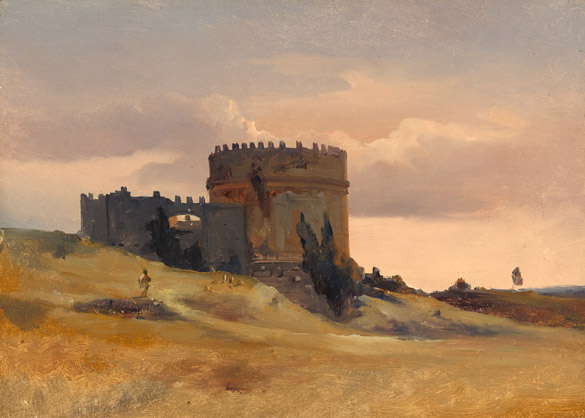
Léon-François-Antoine Fleury,
The Tomb of Caecilia Metella, c. 1830, oil on canvas, National Gallery of Art, Washington, Gift of Frank Anderson Trapp, 2004.166.16
An integral part of art education in the late 18th and early 19th centuries, painting
en plein air was a core practice for avant-garde artists in Europe. Intrepid artists such as
Jean-Baptiste-Camille Corot,
John Constable,
Simon Denis,
Jules Coignet, and
André Giroux—highly skilled at quickly capturing effects of light and atmosphere—made sometimes arduous journeys to paint their landscapes in person at breathtaking sites, ranging from the Baltic coast and Swiss Alps to the streets of Paris and ruins of Rome. Drawing on new scholarship, this exhibition of some 100 oil sketches made outdoors across Europe during that time includes several recently discovered works and explores issues such as attribution, chronology, and technique.
Jules Coignet, View of Bozen with a Painter, 1837
oil on paper, mounted on canvas
Gift of Mrs. John Jay Ide in memory of Mr. and Mrs. William Henry Donner
The exhibition is accompanied by a comprehensive catalog with essays by leading experts in the field and will present new information about this key aspect of European art history.
The exhibition is curated by Mary Morton, curator and head of the department of French paintings, National Gallery of Art, Washington; Ger Luijten, director, Fondation Custodia, Collection Frits Lugt, Paris; and Jane Munro, keeper of paintings, drawings and prints, Fitzwilliam Museum, Cambridge.
Exhibition Highlights
True to Nature begins as European artists would have in the late 18th and early 19th century—in Rome. The study of ancient sculpture and architecture, as well as of Renaissance and baroque art, was already a key part of an artist's education, but Pierre-Henri de Valenciennes's influential treatise on landscape painting, published in 1800, went further to recommended that young artists develop their skills by painting oil sketches out of doors. Valenciennes advised exploring the Roman countryside, as he had in Study of Clouds over the Roman Campagna (c. 1782/1785). This section includes examples by a range of European artists who followed his advice, such as Michel Dumas, Christoffer Wilhelm Eckersberg, and Johan Thomas Lundbye. Also included is The Island and Bridge of San Bartolomeo, Rome (1825/1828) by Jean-Baptiste-Camille Corot. Corot was a key figure in 19th-century landscape painting, bringing the practice of open-air painting back to France and inspiring a younger generation of impressionist painters.
Other sections focus on both natural and man-made features that proved challenging to painters, such as waterfalls, trees, skies, coastlines, and rooftops. Examples include rare studies by well-known artists such as
John Constable's Sky Study with a Shaft of Sunlight(c. 1822, Fitzwilliam Museum),
Jean Honoré Fragonard's Mountain Landscape at Sunset (c. 1765), and
Odilon Redon's Village on the Coast of Brittany (1840–1916, Fondation Custodia) as well as sketches by lesser-known painters like Louise-Joséphine Sarazin del Belmont, one of the few known women artists active during this period.
True to Nature illustrates how pervasive plein-air painting became across Europe with examples by many Belgian, Danish, Dutch, German, Swiss, and Swedish artists who studied in Italy before returning home to paint their native surroundings. Sketches by Carl Blechen include an example from his time in Italy, View of the Colosseum in Rome (1829, Fondation Custodia), as well as a study made at home in Germany, View of the Baltic Coast (1798-1840), Fondation Custodia).
Exhibition Catalog
Published by the Fondation Custodia, Collection Frits Lugt,
a comprehensive catalog with essays by leading experts in the field will present new information about this key aspect of European art history. Authors include the curatorial team and Michael Clarke, former director of the Scottish National Gallery and deputy director of the National Galleries of Scotland; Anna Ottani Cavina, director of the Fondazione Federico Zeri, Bologna, and professor of art history of the department of visual arts, University of Bologna; and Ann Hoenigswald, former senior conservator of paintings, National Gallery of Art, Washington. With some 140 color illustrations and 250 pages





